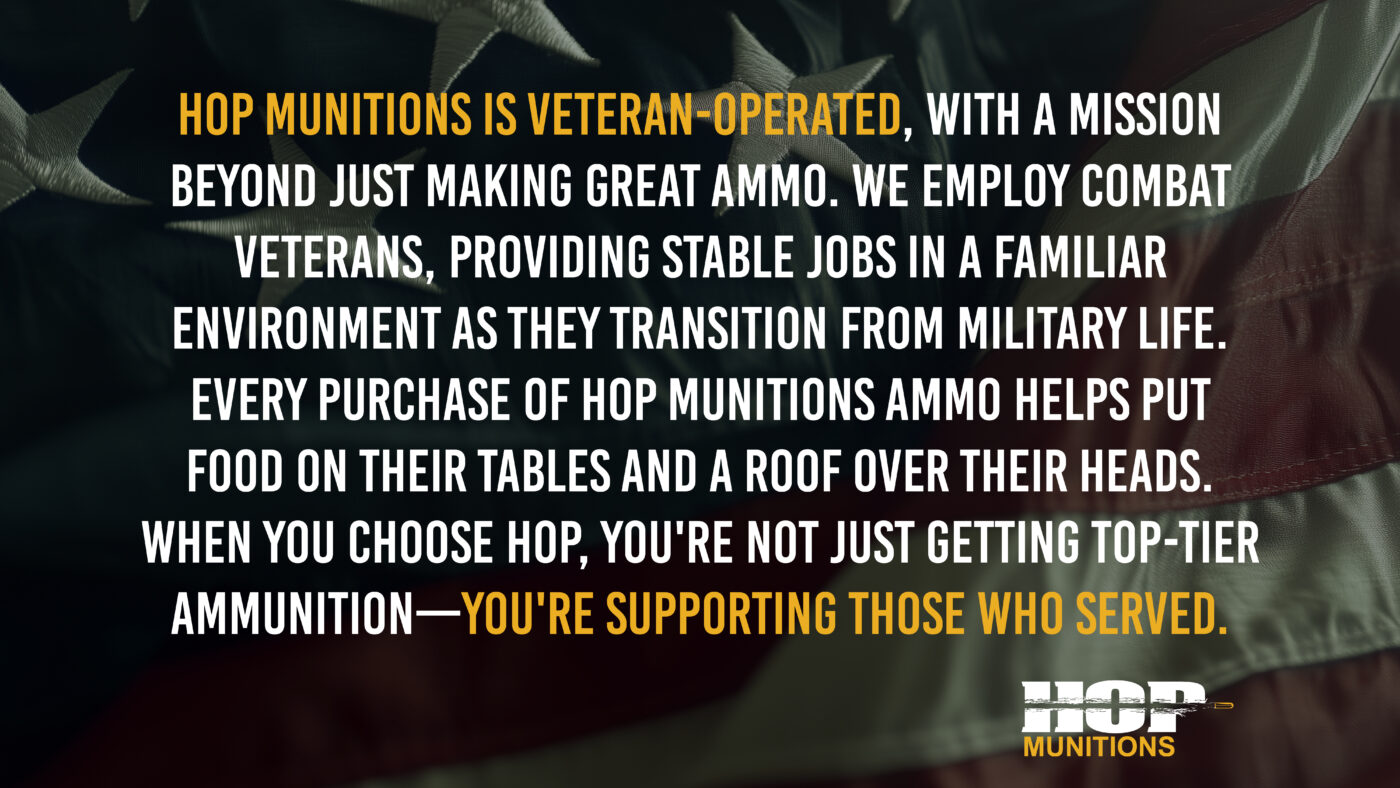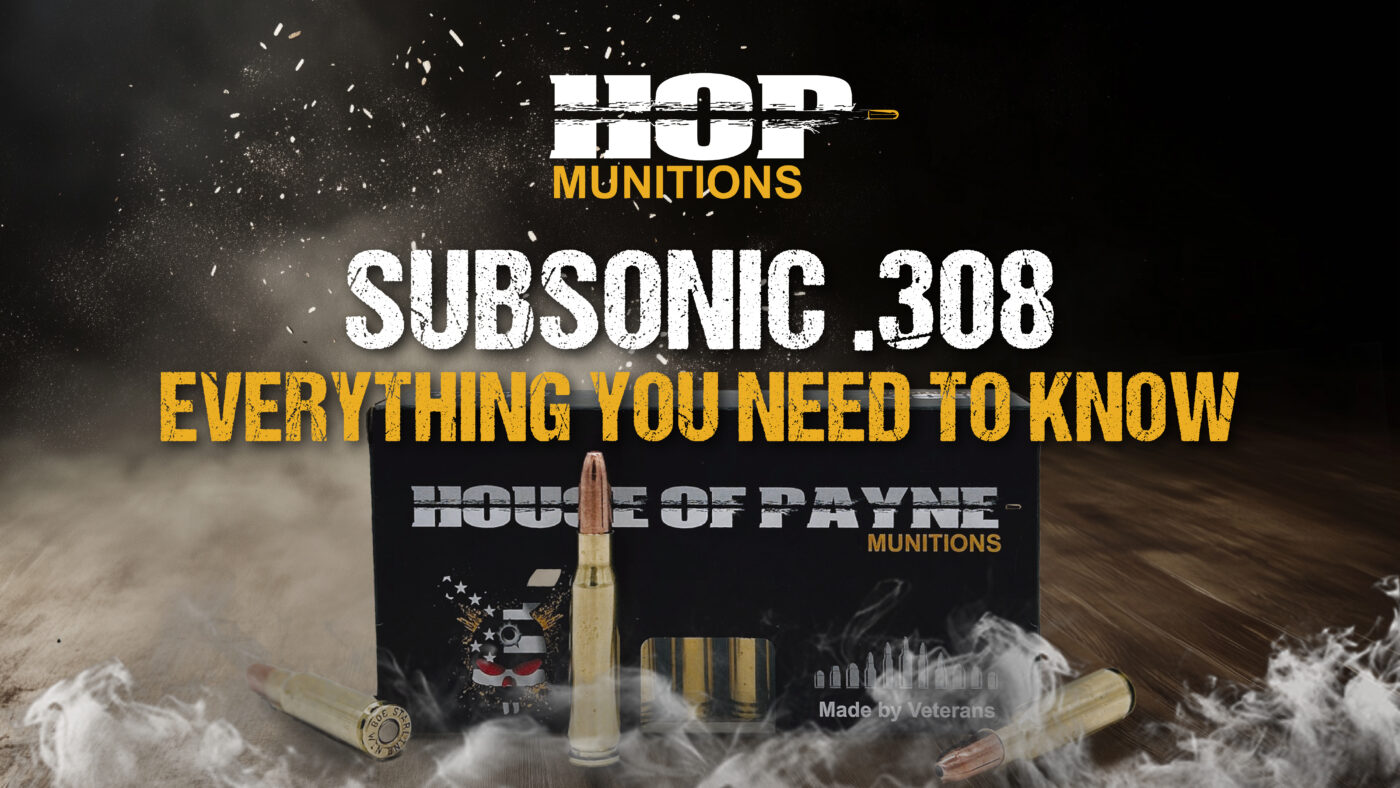HOP Blog
Subsonic .308 Q&A: Everything You Need to Know
This Q&A answers the most common questions about subsonic .308, from hunting effectiveness and ballistics to cycling reliability and range limitations.
Let’s break it down so you can decide if subsonic .308 fits your needs.
Can You Hunt With Subsonic .308 Ammo?
Yes, you can hunt with subsonic .308 ammo, but shot placement and range are critical. Unlike traditional .308 loads, which rely on high velocity for energy transfer and expansion, subsonic rounds move at much lower speeds—typically under 1,100 feet per second (fps). This means they don’t expand as aggressively as supersonic bullets, making bullet selection crucial.
For hunting, solid copper expanding subsonic rounds—like those from HOP Munitions—are ideal because they maximize penetration and controlled expansion. These rounds can be effective for medium-sized game like deer and hogs within 100 yards, but hunters must be mindful of the reduced energy and drop-off in trajectory compared to standard loads.
READ MORE – Best Subsonic 308 Ammo For Hunting
Will Subsonic .308 Kill a Hog?
Yes, subsonic .308 can kill a hog, but proper shot placement is key. Since subsonic rounds generate significantly less energy than supersonic loads, hitting vital areas—such as the brain or heart/lung region—is essential for an ethical and effective kill.
A solid copper expanding subsonic round, like those from HOP Munitions, is ideal for hog hunting because it delivers deep penetration and controlled expansion, ensuring a lethal shot. However, due to the lower velocity, effective range is generally within 75-100 yards. Anything beyond that, and you risk the bullet losing too much energy for a clean kill.
READ MORE – Best .308 Hunting Ammo for Hogs
What Is the Benefit of a Subsonic .308 Round?
The biggest benefit of subsonic .308 is its lack of a sonic crack and reduced recoil, making it an excellent choice for suppressed shooting. Since these rounds travel below the speed of sound, they eliminate the sonic crack produced by supersonic bullets, making them much quieter when paired with a suppressor.
Other advantages include:
- Reduced noise signature – Ideal for hunting, tactical applications, or discreet shooting.
- Less recoil – Easier to shoot, especially for those sensitive to recoil.
- Better performance in short barrels – Works well in suppressed bolt-action rifles and short-barreled setups.
- Minimized overpenetration – Lower velocity reduces the risk of bullets passing through targets, making it a safer option in some scenarios.
READ MORE – Subsonic 308 vs 300 Blackout
Will Subsonic .308 Cycle?
Whether subsonic .308 will cycle depends on the rifle type and gas system. In most semi-automatic rifles, subsonic rounds will not generate enough gas pressure to reliably cycle the bolt, leading to failure to eject or chamber the next round. This is because subsonic loads use less powder and lower velocities, reducing the necessary gas pressure needed for proper function.
However, there are a few ways to improve cycling with subsonic .308:
- Using an adjustable gas block – Allows you to fine-tune gas flow for better cycling.
- Running a suppressor – Increases backpressure, which can help with semi-auto function.
- Using a bolt-action rifle – Since cycling is manual, subsonic .308 performs flawlessly in bolt guns.
How Far Can You Shoot Subsonic .308?
Subsonic .308 can be used at distances beyond 300 yards, but its practical effective range is much shorter due to bullet drop and loss of energy. Unlike supersonic rounds that maintain a flatter trajectory, subsonic bullets drop significantly past 100 yards, requiring major holdovers for longer shots.
For precision shooting, most subsonic .308 users keep their shots within 200 yards max. Beyond that, wind drift and bullet drop make hits much harder to predict.
For hunting applications, the effective range is typically limited to 100 yards or less, ensuring enough energy for a clean kill.
How Far Is Subsonic .308 Effective?
The effective range of subsonic .308 depends on what you’re using it for.
- For hunting: Subsonic .308 is most effective within 100 yards. Beyond that, the bullet loses too much energy for a reliable, ethical kill.
- For target shooting: You can shoot subsonic .308 at 200-300 yards, but bullet drop becomes extreme, requiring significant adjustments.
How Fast Is Subsonic .308?
Subsonic .308 rounds are designed to stay below the speed of sound, which is typically 1,125 feet per second (fps) at sea level but can vary slightly based on altitude and temperature.
Most factory subsonic .308 loads travel between 950 and 1,050 fps, ensuring they remain quiet and suppressor-friendly. This is significantly slower than standard .308 rounds, which often exceed 2,600 fps.
The exact velocity can vary depending on:
- Bullet weight – Heavier bullets (e.g., 190-220 grains) tend to be used in subsonic loads for better energy retention.
- Barrel length – Shorter barrels typically produce slightly lower velocities, while longer barrels can add a small velocity boost.
- Ammunition brand – Different manufacturers fine-tune their loads for specific performance.
How Quiet Is a Suppressed Subsonic .308?
A suppressed subsonic .308 is significantly quieter than standard supersonic loads, making it ideal for stealthy shooting. When paired with a quality suppressor, the sound level typically drops to 120-130 decibels (dB)—roughly equivalent to a .22 LR rifle or a nail gun.
For comparison:
- Unsuppressed supersonic .308 – ~160-170 dB (as loud as a jet engine).
- Unsuppressed subsonic .308 – ~140-150 dB (still loud but no supersonic crack).
- Suppressed subsonic .308 – ~120-130 dB (similar to a suppressed .22 LR).
While it’s not completely silent, the lack of a sonic crack makes it much harder to pinpoint, especially at a distance. This makes subsonic .308 a great option for hunting, tactical use, or backyard target shooting in areas where noise reduction is essential.
What Is the Energy of a Subsonic .308?
Subsonic .308 produces significantly less energy than its supersonic counterpart due to its lower velocity. While a standard 150-grain supersonic .308 round can generate over 2,500 foot-pounds (ft-lbs) of energy, subsonic loads typically produce 400-600 ft-lbs—roughly equivalent to a .45 ACP or .44 Magnum.
The exact energy depends on:
- Bullet weight – Heavier projectiles (e.g., 190-220 grains) help retain more energy.
- Muzzle velocity – Most subsonic loads stay between 950-1,050 fps, affecting energy output.
Even though the energy is lower, subsonic .308 can still be lethal within 100 yards when using expanding solid copper bullets that maximize penetration and wound channel effectiveness.
Does Barrel Length Matter for Subsonic .308?
Yes, barrel length does matter for subsonic .308, but not in the same way as supersonic loads.
Since subsonic rounds don’t rely on high velocity, a longer barrel won’t significantly increase performance. In fact, many shooters prefer shorter barrels (e.g., 16 inches or less) for subsonic .308 because:
- More maneuverability – Shorter barrels are easier to handle, especially in suppressed setups.
- Better suppression – Less powder burn means less gas noise, making it quieter.
- Minimal velocity difference – Unlike supersonic rounds, subsonic .308 gains very little speed from a longer barrel, typically staying in the 950-1,050 fps range regardless of length.
That said, barrels shorter than 10 inches may cause inconsistent velocity and pressure issues, so most subsonic .308 shooters stick with 12-16 inches for reliable performance.
Ready to run subsonic? Grab a box of HOP Munitions subsonic .308 and experience the difference.


